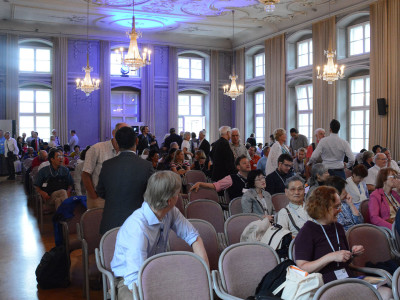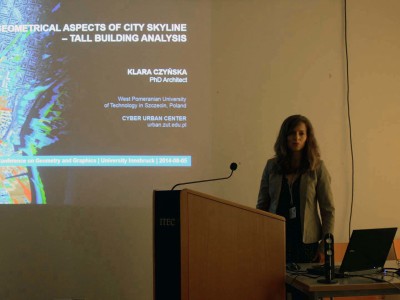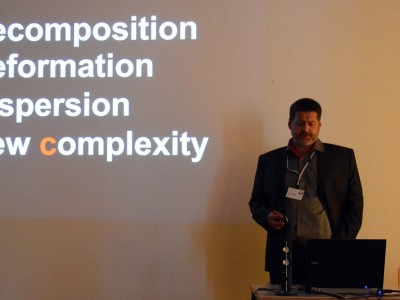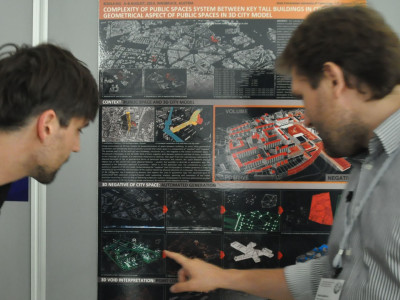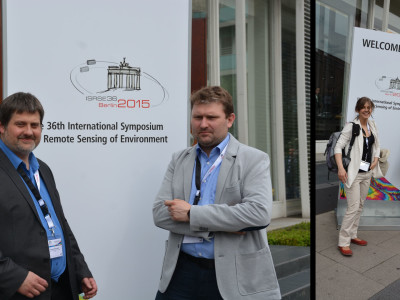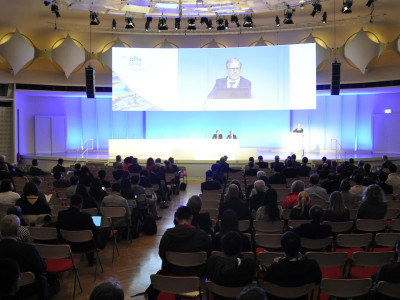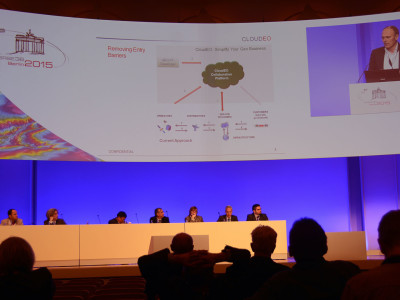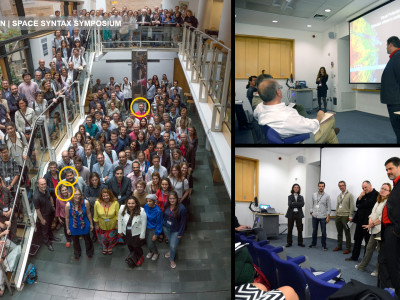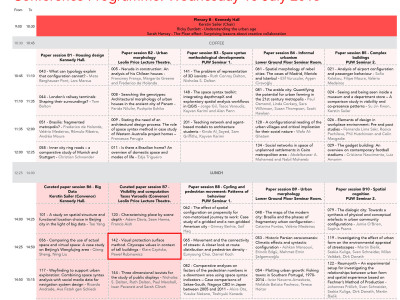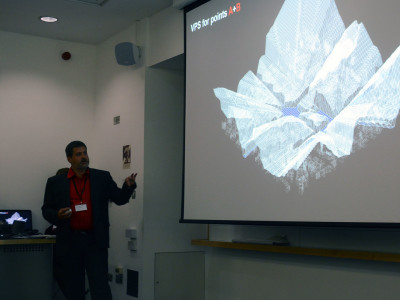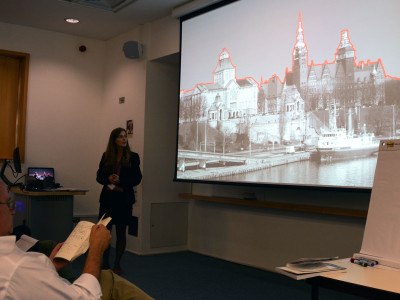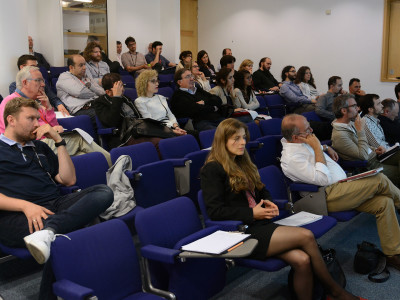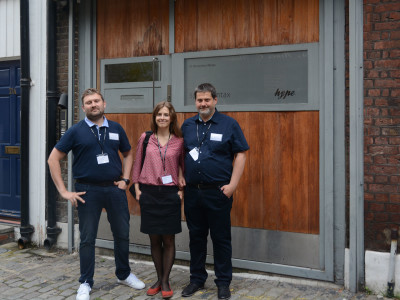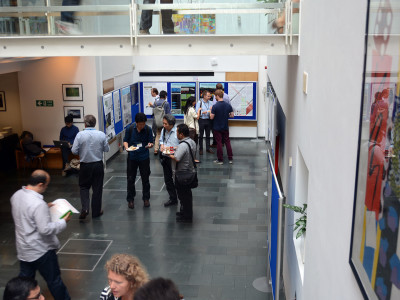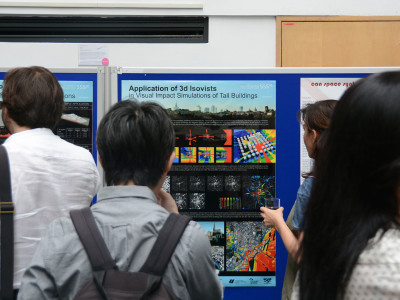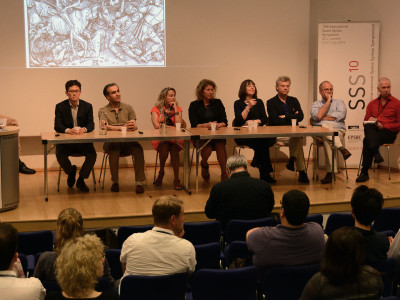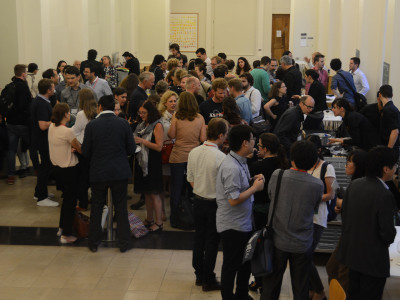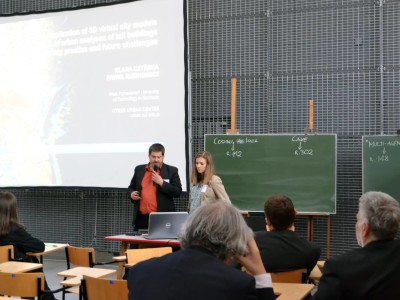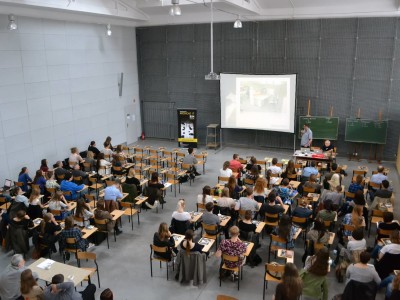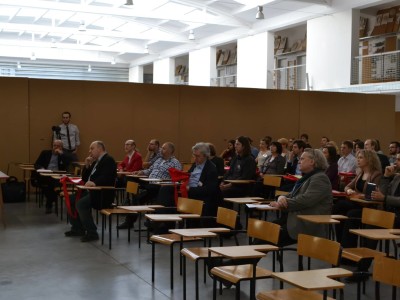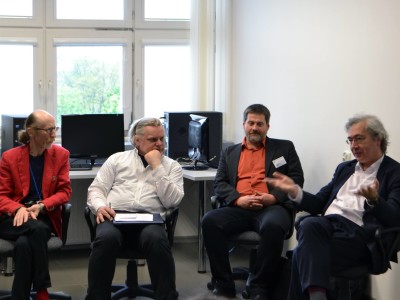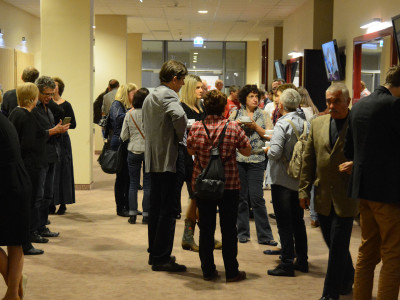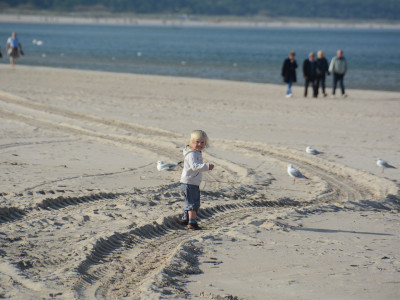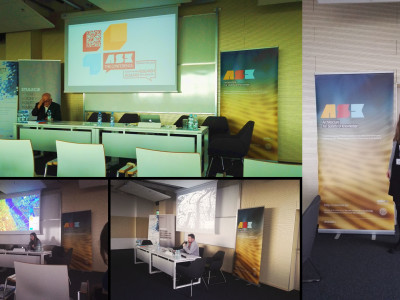
Konferencje
Realizacja projektu 2TaLL wymagała interdyscyplinarnego podejścia: integracji różnych dziedzin naukowych oraz dotarcia do różnych środowisk. Osiągnięciem, istotnym zarówno dla rozpowszechniania wyników przeprowadzonych badań, jak też dla poszerzenia wiedzy wykonawców, był udział i prezentacje na trzech wiodących konferencjach międzynarodowych o różnych profilach naukowych związanych kolejno z: geometrią (ICGG16: International Conference on Geometry and Graphics, Innsbruck 2014), teledetekcją krajobrazu (ISRSE36: International Symposium on Remote Sensing of Environment, Berlin 2015) oraz cyfrową analizą urbanistyczną (SSS10: Space Syntax Symposium, Londyn 2015). Każda z konferencji miała znaczenie dla kierunkowania badań w projekcie.
Konferencje wiodące:
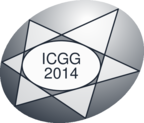 The 16th International Conference on Geometry and Graphics (ICGG 2014) took place in Innsbruck, Austria, on August 4–8, 2014. The ICGG 2014 aims at providing a forum for presentation and discussion of both academic and industrial research involving theoretical and applied geometry and graphics as well as other related fields. The ICGG conference is part of a series of conferences held biannually and sponsored by the International Society for Geometry and Graphics (ISGG). The first Conference was held in Vancouver, Canada (1978), and hosted by the Engineering Design Graphics Division of the American Society for Engineering Education. The conference was called “International Conference on Descriptive Geometry.” Since then the conferences have been held almost every two years.
The 16th International Conference on Geometry and Graphics (ICGG 2014) took place in Innsbruck, Austria, on August 4–8, 2014. The ICGG 2014 aims at providing a forum for presentation and discussion of both academic and industrial research involving theoretical and applied geometry and graphics as well as other related fields. The ICGG conference is part of a series of conferences held biannually and sponsored by the International Society for Geometry and Graphics (ISGG). The first Conference was held in Vancouver, Canada (1978), and hosted by the Engineering Design Graphics Division of the American Society for Engineering Education. The conference was called “International Conference on Descriptive Geometry.” Since then the conferences have been held almost every two years.
Tematy wystąpień:
Geometrical Aspects of City Skyline – Tall Building Analysis – Czyńska K.
Exploring the Complexity. Digital Turn Towards Geometry in Contemporary Architecture and Urban Planning – Rubinowicz P.
Sesja posterowa:
 Complexity of Public Spaces System Between Key Tall Buildings in City of Szczecin. Geometrical Aspect of Public Spaces in 3D City Model – Zwoliński A.
Complexity of Public Spaces System Between Key Tall Buildings in City of Szczecin. Geometrical Aspect of Public Spaces in 3D City Model – Zwoliński A.
 36th International Symposium on Remote Sensing of Environment (ISRSE)took place on May 11-15, 2015 in Berlin, Germany. This 36th Symposium represent a major event in the long series of internationally recognized ISRSE meetings. The overall theme of the symposium is the use of Earth Observation systems and related Remote Sensing techniques for understanding and managing the Earth environment and resources. ISRSE-36 will provide an outstanding opportunity to learn about these major programmes and their first results. It will be a forum to present applications based on these new missions and to exchange views on future directions of Earth Observation technology and geographic information management.
36th International Symposium on Remote Sensing of Environment (ISRSE)took place on May 11-15, 2015 in Berlin, Germany. This 36th Symposium represent a major event in the long series of internationally recognized ISRSE meetings. The overall theme of the symposium is the use of Earth Observation systems and related Remote Sensing techniques for understanding and managing the Earth environment and resources. ISRSE-36 will provide an outstanding opportunity to learn about these major programmes and their first results. It will be a forum to present applications based on these new missions and to exchange views on future directions of Earth Observation technology and geographic information management.
The Symposium will include plenary and thematic sessions, poster sessions and side events on issues of interest to scientists, policy makers and resource managers in the public and private sectors. The programme will feature speakers from around the globe sharing their experiences and knowledge on Earth observation applications and programmes. By attending the ISRSE-36, practitioners, scientists, policy makers, system engineers and students will be able to get a full view of the current situation in a range of fields now deemed critical in the Earth’s sustainable management.
Tematy wystąpień:
- Application of Lidar Data and 3D-City Models in Visual Impact Simulations of Tall Building – Czyńska K.
- Study of City Landscape Heritage Using LiDAR Data and 3d-City Models – Rubinowicz P.
- Computing and monitoring potential of public spaces by shading analysis using 3d LIDAR data and advanced image analysis – Zwoliński A.
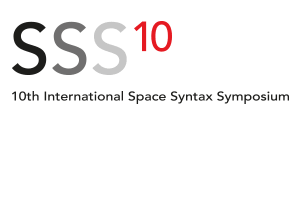 The 10th Space Syntax Symposium (SSS10) was held in London from 13 to 17 July 2015, at University College London, Bloomsbury. The Space Syntax Laboratory, University College London, was hosting the tenth biennial international space syntax symposium – a dozen years on from the last London symposium. The aim of the symposium is to bring together scholars, practitioners and students who are currently working on space syntax and related approaches to share knowledge, discuss theories as well as practical applications and to explore directions for future inquiry. We are aiming to encounter in this symposium a wider and more diverse range of issues, as well as the most advanced and state of the art research in this field.
The 10th Space Syntax Symposium (SSS10) was held in London from 13 to 17 July 2015, at University College London, Bloomsbury. The Space Syntax Laboratory, University College London, was hosting the tenth biennial international space syntax symposium – a dozen years on from the last London symposium. The aim of the symposium is to bring together scholars, practitioners and students who are currently working on space syntax and related approaches to share knowledge, discuss theories as well as practical applications and to explore directions for future inquiry. We are aiming to encounter in this symposium a wider and more diverse range of issues, as well as the most advanced and state of the art research in this field.
Tematy wystąpień:
![]() Visual Protection Surface method. Cityscape values in context of tall buildings – Czyńska K., Rubinowicz P. — Curated paper session B7 – Visibility and computation – Tasos Varoudis (Convenor)
Visual Protection Surface method. Cityscape values in context of tall buildings – Czyńska K., Rubinowicz P. — Curated paper session B7 – Visibility and computation – Tasos Varoudis (Convenor)
Sesja posterowa:
![]() Application of 3D isovists in visual impact simulations of tall buildings – Rubinowicz P., Czyńska K.
Application of 3D isovists in visual impact simulations of tall buildings – Rubinowicz P., Czyńska K.
![]() 3D-negatives of public spaces: detection, analysis and tall buildings relations – Zwoliński A.
3D-negatives of public spaces: detection, analysis and tall buildings relations – Zwoliński A.
Pozostałe konferencje:
W dniach 9-10 maja odbyła się regionalna konferencja ECAADE połączona z międzynarodowymi warsztatami dotyczącymi hybrydowych środowisk projektowania architektonicznego. Było to wydarzenie cykliczne i w 2014 roku przywilej zorganizowania imprezy został przyznany Politechnice Białostockiej przez organizację ECAADE (Education and Research in Computer Aided Architectural Design in Europe). Gościem specjalnym był prezydent ECAADE prof. Johan Vebeke z Universytetu w Leuven (Belgia). W konferencji i warsztatach brali udział przedstawiciele uczelni z Europy: Polski, Austrii, Belgii, Danii, Litwy i Białorusi oraz firm informatycznych. Tematyka warsztatów obejmowała zagadnienia zaawansowanych technologii dla projektowania architektonicznego: wirtualnej rzeczywistości, projektowania parametrycznego, skanowania i druku 3D, technologii CAVE.
Tematy wystąpień:
- Application of 3D virtual city models in urban analyses of tall buildings – today practice and future challenges – Czyńska K., Rubinowicz P.
- A day in a shadow of high-rise – 3D parameterization and use of public space around PŻM / Hotel Radisson building complex in center of Szczecin – Zwoliński A.
Celem XVII Forum Architektury Krajobrazu jest przedstawienie i dyskusja nad dorobkiem współczesnej architektury krajobrazu w Polsca ze szczególnym uwzględnieniem problematyki dotyczącej oceny atrakcyjności krajobrazu i przez to możliwości jego skutecznej ochrony i kreacji.
Strona poświęcona konferencji >>>
Tematy wystąpień:
- Atrakcyjność krajobrazu miejskiego a zabudowa wysoka – na przykładzie wybranych miast europejskich – Czyńska K.
„Zmiany systemowe – nowa szansa dla zabytków” – to hasło tegorocznej konferencji, poświęconej ochronie zabytków, która odbyła 10-11 grudnia br. w Akademii Sztuk Pięknych w Gdańsku. Obrady otworzyła dr Magdalena Gawin – Generalny Konserwator Zabytków. Wśród tematów znalazły się m.in. historyczne uwarunkowania systemu ochrony zabytków w Polsce oraz współczesne problemy i wyzwania związane z tymi zagadnieniami. Na konferencji m.in. przedstawiono różne systemy prawne ochrony zabytków za granicą oraz omówiono propozycje zmian w istniejącym systemie w Polsce. Wśród prelegentów znaleźli się m.in. Rafał Nadolny – Mazowiecki Wojewódzki Konserwator Zabytków, Dariusz Chmielewski – Pomorski Wojewódzki Konserwator Zabytków, oraz Michał Socha – Prezes Instytutu Zrównoważonej Przestrzeni. Drugiego dnia obrad Wiceminister Kultury i Dziedzictwa Narodowego Jarosław Sellin odczytał list od prezydenta Andrzeja Dudy adresowany do uczestników konferencji. Omówiono także działania konserwatorskie i rewitalizacyjne na wybranych przykładach. W wydarzeniu uczestniczyli: wojewódzcy konserwatorzy zabytków, historycy sztuki, architekci oraz eksperci. Organizatorami wydarzenia byli: Mazowiecki Wojewódzki Konserwator Zabytków, Pomorski Wojewódzki Konserwator Zabytków oraz Instytut Zrównoważonej Przestrzeni przy współpracy z Akademią Sztuk Pięknych w Gdańsku.
Tematy wystąpień:
- Projekt 2TaLL – Wirtualne modele miast w analizach urbanistycznych – Czyńska K., Rubinowicz P., Zwoliński A.
ASK.the.conference had its first edition exploring the role of research in the creative practice and the education of professionals focusing on architecture and spatial planning. Supported by Research by Design the conference combined theory and applied science, academia and practice for the creative transformation of our human space taking into account a consistent environmental awareness. It was an opportunity to showcase best practices, state-of-the art research and innovative approaches to teaching.
Tematy wystąpień:
- Visual Impact Size method in planning tall buildings – Czyńska K.
- Geometries of cityscape. Analysis and detection of public spaces beneath tall buildings by 3d-negatives – Zwoliński A.

